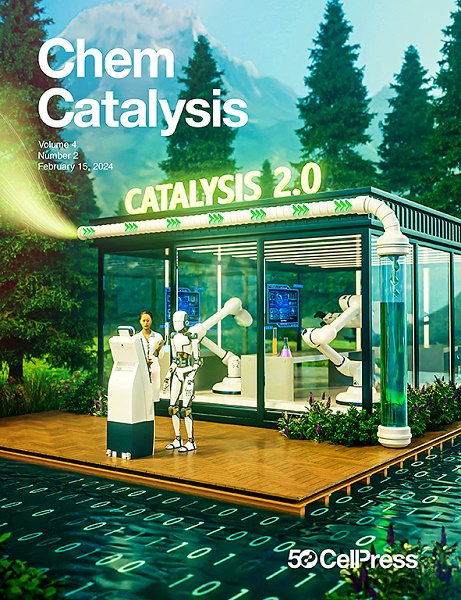Ligands-regulated ∗CO adsorption on two-dimensional covalent organic framework promotes selective electrochemical CO2 conversion
IF 11.5
Q1 CHEMISTRY, PHYSICAL
引用次数: 0
Abstract
Manipulating the adsorption/desorption of intermediates at active sites offers a promising strategy to direct specific electrocatalytic pathways. In high overpotential regimes, the desorption of ∗CO from active sites is a major limitation in electrochemical CO2-to-CO conversion, emphasizing the need to control ∗CO adsorption strength. Here, we report a series of well-defined amide-linked covalent organic frameworks (COFs) featuring alternating tetraaminophenylporphyrin and tetracarboxyphenylporphyrin building blocks, with M1 and M2 sites (M1/M2 = Co, Fe). Electrochemical tests and computational models reveal that the polar ligand framework plays a key role in regulating ∗CO adsorption, a conclusion supported by operando spectroelectrochemical measurements. Theoretical calculations attribute this regulation to the differing band centers of the transition metals, driven by intra-layer charge transfer from polar amine bonds. This work underscores the importance of polar ligands in optimizing intermediate adsorption and enhancing CO2 transformation efficiency.

配体调控的* CO在二维共价有机框架上的吸附促进了选择性的电化学CO2转化
操纵中间体在活性位点的吸附/解吸为指导特定的电催化途径提供了一种有前途的策略。在高过电位状态下,从活性位点解吸* CO是电化学CO2-to-CO转化的主要限制,强调需要控制* CO的吸附强度。在这里,我们报道了一系列定义明确的酰胺连接的共价有机框架(COFs),具有交替的四氨基苯基卟啉和四羧基苯基卟啉构建块,具有M1和M2位点(M1/M2 = Co, Fe)。电化学测试和计算模型表明,极性配体框架在调节* CO吸附中起关键作用,这一结论得到了operando光谱电化学测量的支持。理论计算将这种调节归因于过渡金属的不同dz2带中心,由极性胺键的层内电荷转移驱动。这项工作强调了极性配体在优化中间吸附和提高CO2转化效率方面的重要性。
本文章由计算机程序翻译,如有差异,请以英文原文为准。
求助全文
约1分钟内获得全文
求助全文
来源期刊
CiteScore
10.50
自引率
6.40%
发文量
0
期刊介绍:
Chem Catalysis is a monthly journal that publishes innovative research on fundamental and applied catalysis, providing a platform for researchers across chemistry, chemical engineering, and related fields. It serves as a premier resource for scientists and engineers in academia and industry, covering heterogeneous, homogeneous, and biocatalysis. Emphasizing transformative methods and technologies, the journal aims to advance understanding, introduce novel catalysts, and connect fundamental insights to real-world applications for societal benefit.

 求助内容:
求助内容: 应助结果提醒方式:
应助结果提醒方式:


